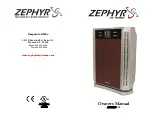
En-2
1-2. SELECTING THE INSTALLATION LOCATION
INDOOR UNIT
• Where airflow is not blocked.
• Where cool (or warm) air spreads over the entire room.
• Rigid wall without vibration.
• Where it is not exposed to direct sunshine. Do not
expose to direct sunshine also during the period fol
-
lowing unpacking to before use.
• Where easily drained.
• At a distance 1 m or more away from your TV and ra-
dio. Operation of the air conditioner may interfere with
radio or TV reception. An amplifier may be required
for the affected device.
• In a place as far away as possible from fluorescent
and incandescent lights.
In order to make the infrared remote control operate
the air conditioner normally.
The heat from the lights may cause deformation or
the ultraviolet may cause deterioration.
• Where the air filter can be removed and replaced
easily.
• Where it is away from the other heat or steam source.
REMOTE CONTROLLER
• Where it is easy to operate and easily visible.
• Where children cannot touch it.
• Select a position about 1.2 m above the floor and
check that signals from the remote controller are
surely received by the indoor unit from that position
(‘beep’ or ‘beep beep’ receiving tone sounds). After
that, attach remote controller holder to a pillar or wall
and install wireless remote controller.
Note:
In rooms where inverter type fluorescent lamps are
used, the signal from the wireless remote controller
may not be received.
Note:
Avoid the following places for installation where air
conditioner trouble is liable to occur.
• Where flammable gas could leak.
• Where there is much machine oil.
• Where oil is splashed or where the area is filled
with oily smoke (such as cooking areas and fac
-
tories, in which the properties of plastic could be
changed and damaged).
• Salty places such as the seaside.
• Where sulfide gas is generated such as hot spring,
sewage, waste water.
• Where there is high-frequency or wireless equip-
ment.
• Where there is emission of high levels of VOCs,
including phthalate compounds, formaldehyde,
etc., which may cause chemical cracking.
1-3. SPECIFICATIONS
*1 Connect to the power switch which has a gap of 3 mm
or more when open to interrupt the source power phase.
(When the power switch is shut off, it must interrupt all
phases.)
*2 Use wires in conformity with design 60245 IEC 57.
*3 Never use pipes with thickness less than specified. The
pressure resistance will be insufficient.
*4 Use a copper pipe or a copper-alloy seamless pipe.
*5 Be careful not to crush or bend the pipe during pipe
bending.
*6 Refrigerant pipe bending radius must be 100 mm or
more.
*7 Refer to the installation manual of the multi-type outdoor
units.
*8 Insulation material : Heat resisting foam plastic 0.045
specific gravity
*9 Be sure to use the insulation of specified thickness.
Excessive thickness may cause incorrect installation
of the indoor unit and insufficient thickness may cause
dew drippage.
Model
Power supply *1
Wire specifications *2
Pipe size
(thickness *3, *4)
Indoor unit
Outdoor unit
Rated Voltage
Frequency Breaker capacity
Power supply
Indoor/outdoor connecting wire
Gas / Liquid
MSZ-AP15VF
MSZ-AP20VF
–
*7
230 V
50 Hz
–
*7
–
*7
4-core
1.0 mm
2
ø9.52 / 6.35 mm
(0.8 mm)
CAUTION
(Could lead to serious injury in particular environments when operated incorrectly.)
n
Install an earth leakage breaker depending on
the installation place.
If an earth leakage breaker is not installed, it could
cause electric shock.
n
Perform the drainage/piping work securely
according to the installation manual.
If there is defect in the drainage/piping work, water
could drop from the unit, soaking and damaging
household goods.
n
Do not touch the air inlet or the aluminum fins
of the outdoor unit.
This could cause injury.
n
Do not install the outdoor unit where small
animals may live.
If small animals enter and touch the electric parts
inside the unit, it could cause a malfunction, smoke
emission, or fire. Also, advise user to keep the area
around the unit clean.
n
Do not operate the air conditioner during inte-
rior construction and finishing work, or while
waxing the floor.
Before operating the air conditioner, ventilate the
room well after such work is performed. Otherwise, it
may cause volatile elements to adhere inside the air
conditioner, resulting in water leakage or scattering
of dew.
JG79J074H01_en.indd 2
2017/09/27 9:46:39




































